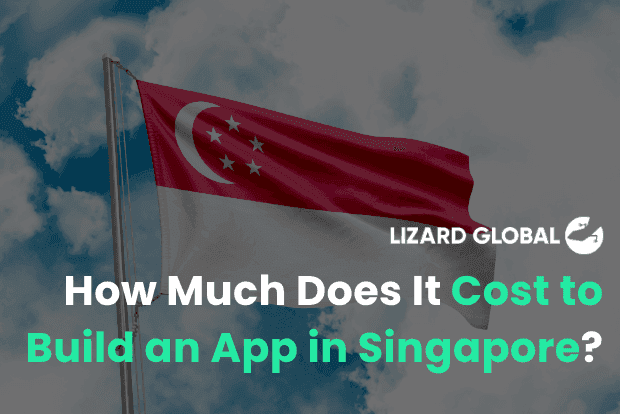Agile
Waterfall
+ 2 more ...
Agile vs Waterfall: Definition, Practises & Benefits

12 Jul 2024
by Nadiy, Senior Content Writer

12 Jul 2024
by Nadiy, Senior Content Writer
Agile
Waterfall
Software Development
Project Management
Agile vs Waterfall: Definition, Practises & Benefits
Table of contents
Contact us
We will get back to you in the next 48 hours.

Agile vs Waterfall Definition, Practises & Benefits
Want to know the difference between the Agile methodology and the Waterfall methodology? Here’s a blog that explains the differences, benefits, and the key practices of both these methodologies.
key takeaways
In software development there are two main project management methodologies used - Agile and Waterfall. Each methodology has its own set of principles, processes, and best practices. When it comes to choosing the best approach for your project is it crucial to understand the differences of these methodologies as it is very much dependent on the specific needs and content of your project.
In this blog, we dive deep into these methodologies, what are they, what are the key practices, what are their benefits, and what are the differences between them. Let’s get started!
What is Agile Methodology
Agile is a repetitive, incremental, and dynamic approach to project management and software development. It prioritizes flexibility, collaboration, customer feedback, and small, rapid releases. Unlike the traditional linear methodology, agile ways of working breaks projects down to an almost granular level called iterations or sprints - with each sprint being between 2 to 4 weeks.
In each sprint you’ll be planning, designing, developing, testing, and reviewing your project. This is a great approach as it gives your team time to adapt to changes swiftly and deliver frequent functional increments of the product.
Agile also focuses on continuous customer feedback, cross-functional collaboration, and self-organizing environments to help reduce risks through early issue identification and addressing. This makes way for higher quality products as there is always regular testing and integration.
Key practices in Agile methodology
- Daily stand-up meetings for team synchronization
- Regular retrospectives for process refinement
- Use of user stories to keep development focused on delivering customer value
Key Principles of Agile:
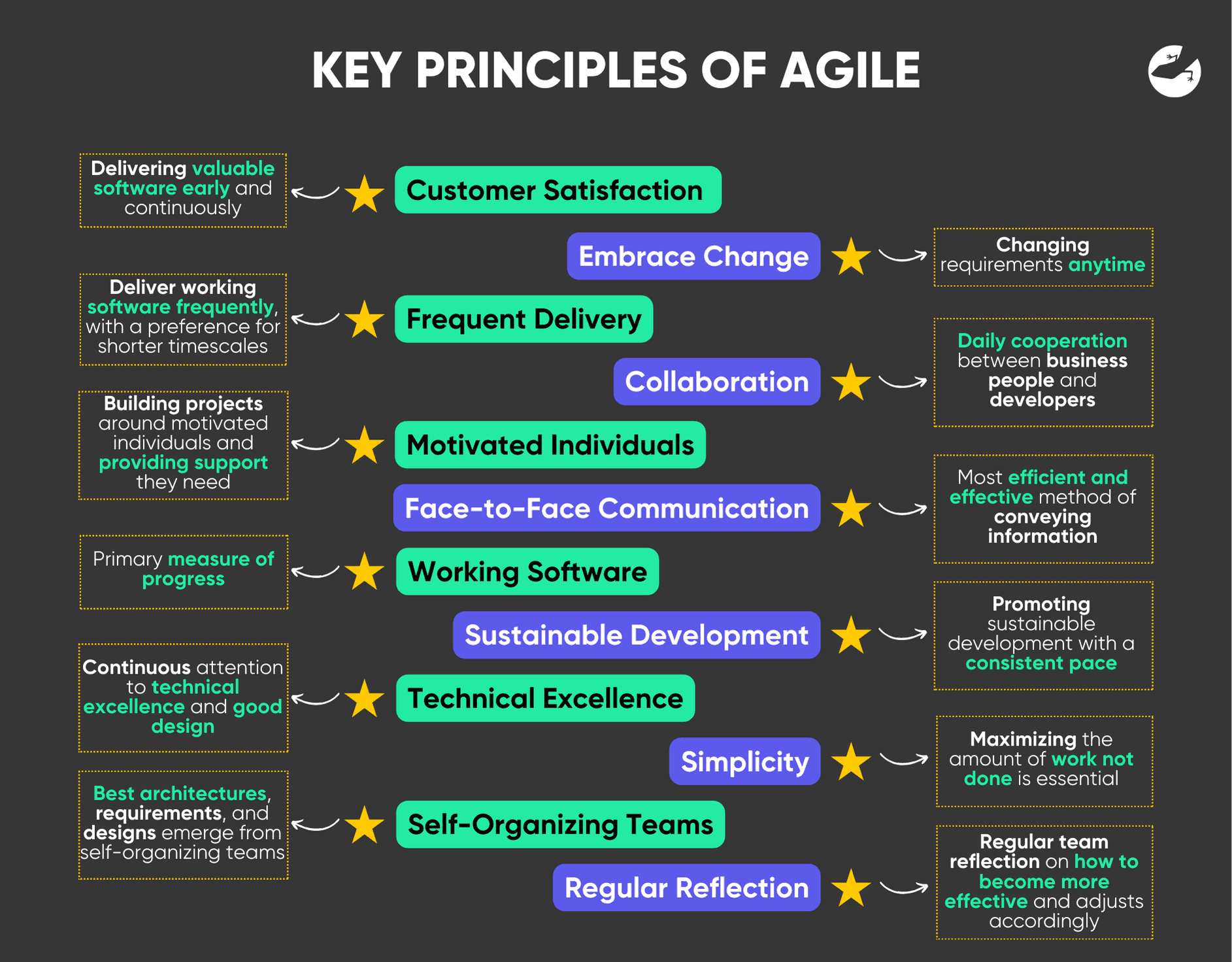
- Customer Satisfaction: Delivering valuable software early and continuously
- Embrace Change: Welcoming changing requirements, even late in development
- Frequent Delivery: Deliver working software frequently, with a preference for shorter timescales
- Collaboration: Close, daily cooperation between business people and developers
- Motivated Individuals: Building projects around motivated individuals and providing the support they need
- Face-to-Face Communication: The most efficient and effective method of conveying information
- Working Software: The primary measure of progress
- Sustainable Development: Promoting sustainable development with a consistent pace
- Technical Excellence: Continuous attention to technical excellence and good design
- Simplicity: Maximizing the amount of work not done is essential
- Self-Organizing Teams: The best architectures, requirements, and designs emerge from self-organizing teams
- Regular Reflection: At regular intervals, the team reflects on how to become more effective and adjusts accordingly
Learn how MVPs (Minimum Viable Product) helps improve customer satisfaction.
Benefits of Agile:
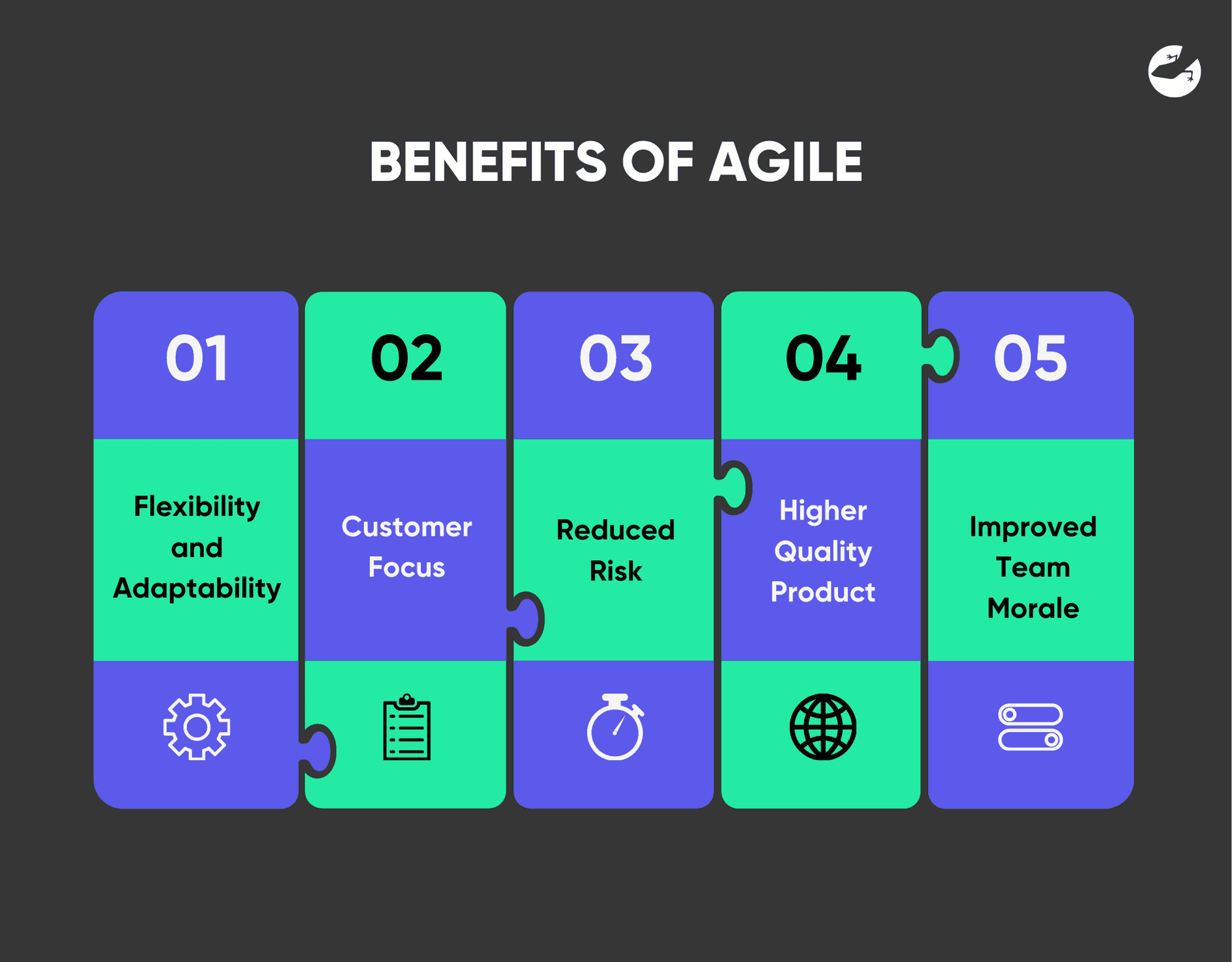
- Flexibility and Adaptability: Agile can quickly adapt to changing requirements and market conditions.
- Customer Focus: Regular feedback ensures the product meets customer needs.
- Reduced Risk: Frequent releases mean issues are identified and addressed early.
- Higher Quality: Continuous testing and integration lead to higher quality products.
- Improved Team Morale: Emphasis on collaboration and self-organization can lead to higher job satisfaction.
Check out how Lean Analytics is crucial for a business to thrive!
What is Waterfall Methodology
In software development and project management, the Waterfall approach is linear and sequential. It focuses on thorough planning, documentation, and a structured process. In this approach, the project is divided into 6 distinct phases with each phase needing to be completed before moving on to the next. This leaves little room for revisiting previous stages once they are finished.
Heavily relying on detailed documentation and upfront requirements gathering, the Waterfall approach requires every aspect of the project is well-defined and understood before development begins. This linear approach provides a clear structure and predictable timelines that makes managing and controlling large projects with stable requirements.
It is less flexible compared to the agile approach when it comes to accommodating changes once the project is underway, as any modifications can be costly and time-consuming to implement. It may also be an issue as the testings are done at the later stage and there is a need for rework to be done.
6 Key Phases of Waterfall:
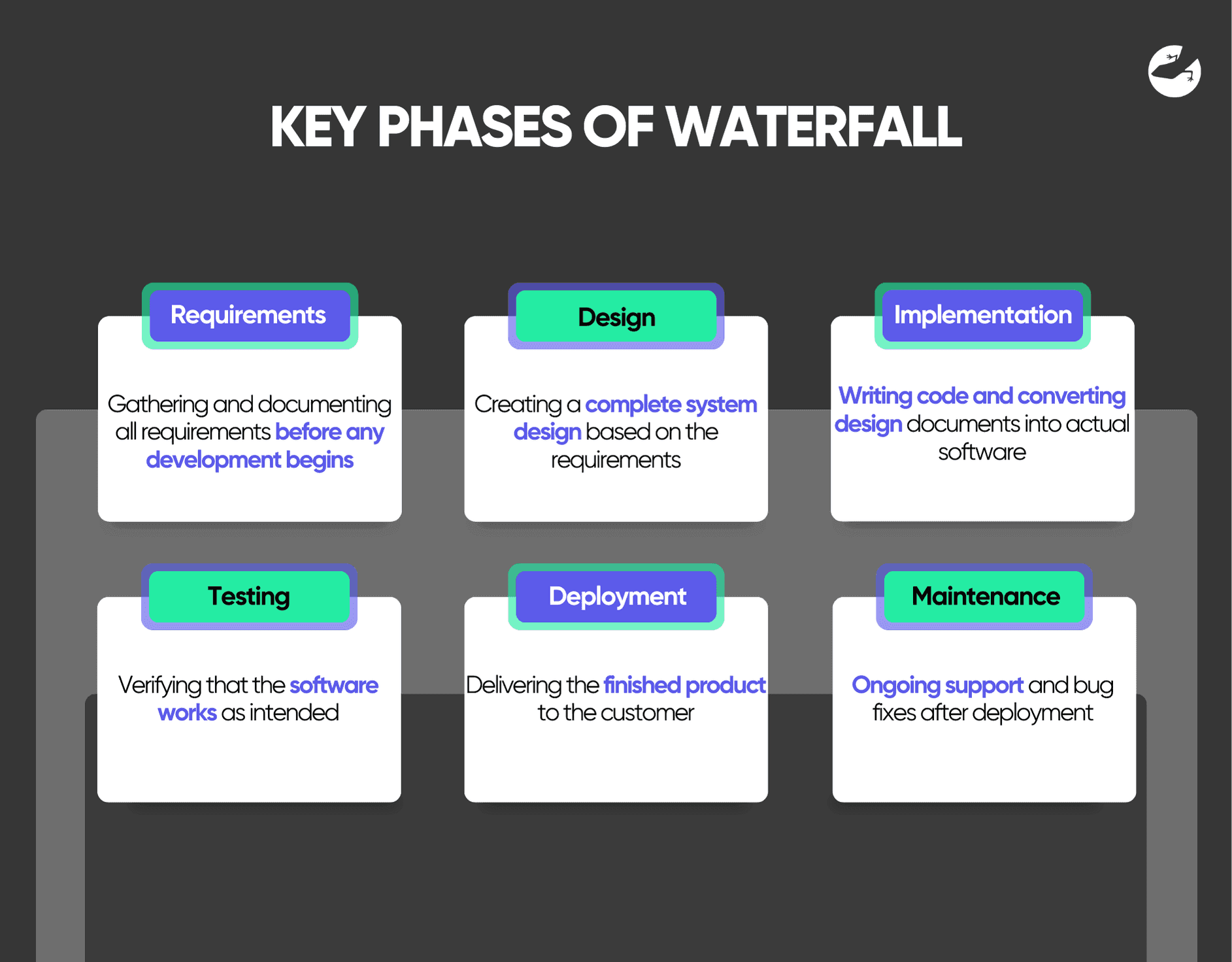
- Requirements: Gathering and documenting all requirements before any development begins.
- Design: Creating a complete system design based on the requirements.
- Implementation: Writing code and converting design documents into actual software.
- Testing: Verifying that the software works as intended.
- Deployment: Delivering the finished product to the customer.
- Maintenance: Ongoing support and bug fixes after deployment.
Curious about how to choose your project Key Objectives? Read our Insight Into OKRs and KPIs here.
Benefits of Waterfall:

- Clear Structure: The sequential approach provides a clear structure and milestones.
- Detailed Documentation: Thorough documentation can be valuable for future maintenance and understanding.
- Predictable Timelines: With a defined scope and plan, timelines can be more predictable.
- Ease of Management: The linear nature makes it easier to manage and control.
What Are The Differences Between Agile and Waterfall
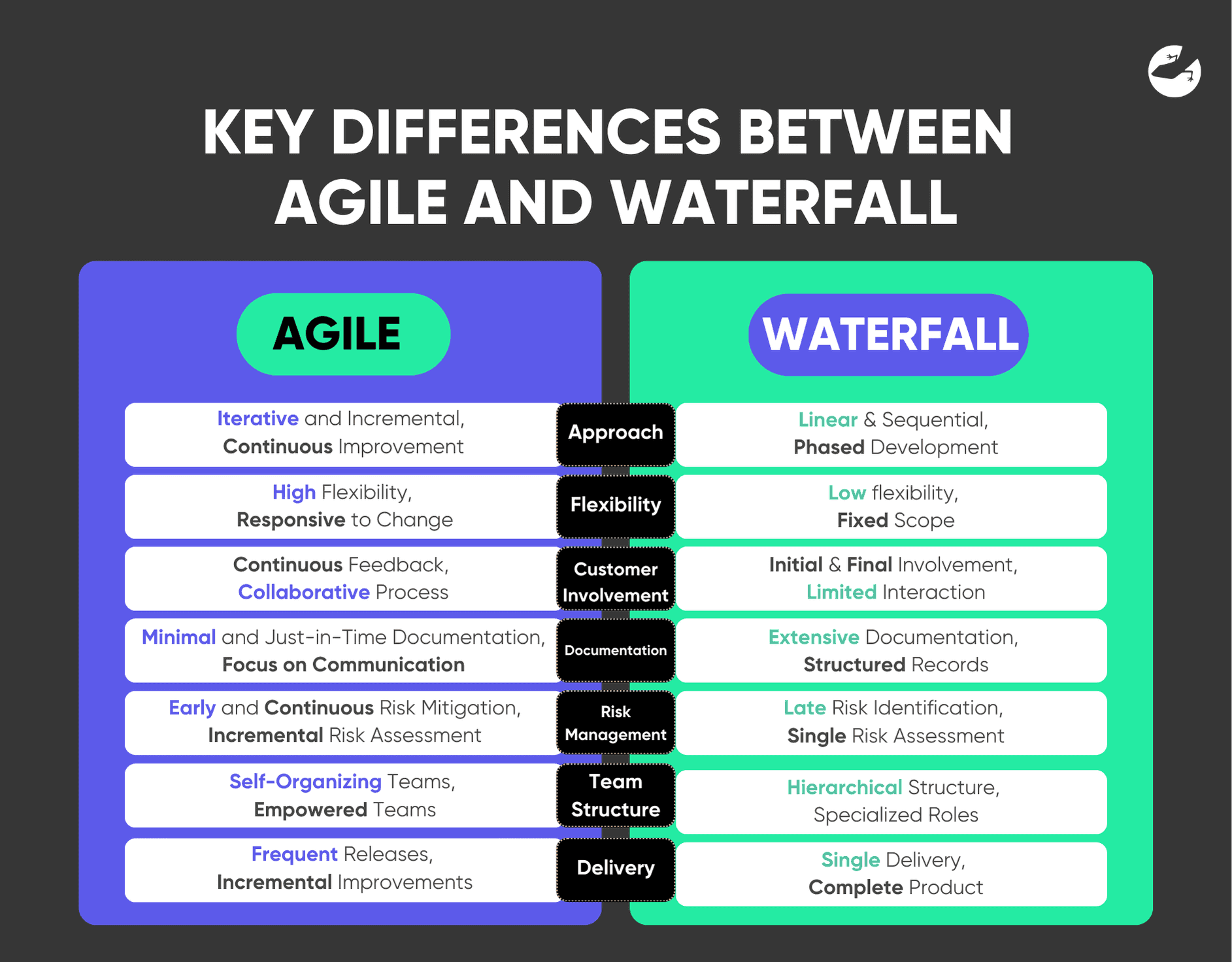
1. Approach:
Agile
- Iterative and Incremental: Agile breaks the project into small, manageable units (sprints) , typically lasting 2-4 weeks. Each iteration involves planning, design, development, testing, and review. This allows for incremental delivery of the product, with each iteration building upon the previous one.
- Continuous Improvement: Agile teams continuously review and refine their processes, seeking ways to improve efficiency and product quality. #### Waterfall
- Linear and Sequential: Waterfall follows a strict linear progression of phases. Each phase must be completed before moving to the next. The process flows in one direction like a waterfall.
- Phased Development: The project is divided into distinct phases: Requirements, Design, Implementation, Testing, Deployment, and Maintenance. Each phase has specific deliverables and a review process.
2. Flexibility:
Agile
- High Flexibility: Agile is designed to adapt to changing requirements at any stage of the project. Changes can be incorporated into the next iteration without derailing the entire project.
- Responsive to Change: Agile welcomes changing requirements, even late in the development process, to ensure the final product meets the current needs of the customer. #### Waterfall
- Low Flexibility: Once a phase is completed, it is challenging and costly to go back and make changes. Requirements are gathered at the beginning, and changes are not easily accommodated later.
- Fixed Scope: The project scope is defined upfront, and deviations from the plan are minimized.
3. Customer Involvement:
Agile
- Continuous Feedback: Agile involves customers throughout the project, providing regular feedback during each iteration. This ensures that the product evolves according to customer needs and expectations.
- Collaborative Process: Customers, developers, and stakeholders work closely together, fostering a collaborative environment.
Waterfall
- Initial and Final Involvement: Customers are primarily involved at the beginning (requirements gathering) and the end (acceptance testing) of the project. This can lead to a disconnect between customer expectations and the final product.
- Limited Interaction: There is less interaction between customers and the development team during the project.
4. Documentation:
Agile
- Minimal and Just-in-Time Documentation: Agile emphasizes working software over comprehensive documentation. Documentation is created as needed and kept to a minimum to support communication and development.
- Focus on Communication: Agile relies more on face-to-face communication and collaboration rather than extensive written documentation.
Waterfall
- Extensive Documentation: Waterfall places a strong emphasis on thorough documentation at each phase. Detailed requirements, design documents, test plans, and user manuals are created.
- Structured Records: Documentation serves as a record of the project’s development process and is used for future reference and maintenance.
5. Risk Management:
Agile
- Early and Continuous Risk Mitigation: Agile identifies and addresses risks early and continuously throughout the project. Regular testing and feedback loops help catch issues early, reducing the likelihood of major problems.
- Incremental Risk Assessment: Each iteration allows for reassessment of risks and adjustments to mitigate them.
Waterfall
- Late Risk Identification: Risks are typically identified and addressed later in the project, often during the testing phase. This can lead to significant rework and increased costs if major issues are discovered.
- Single Risk Assessment: Risk assessment is usually conducted at the beginning, with limited opportunities for reassessment.
6. Team Structure:
Agile
- Self-Organizing Teams: Agile teams are self-organizing and cross-functional, meaning they have all the skills necessary to complete the work. Team members collaborate closely and share responsibilities.
- Empowered Teams: Teams have the autonomy to make decisions and adapt their processes for better outcomes.
Waterfall
- Hierarchical Structure: Waterfall projects often have a more hierarchical structure, with clearly defined roles and responsibilities. Decisions are made by project managers and stakeholders.
- Specialized Roles: Team members typically have specialized roles, such as developers, testers, and designers, with less cross-functional collaboration.
7. Delivery:
Agile
- Frequent Releases: Agile delivers working software frequently, often at the end of each iteration. This provides continuous value to the customer and allows for early feedback.
- Incremental Improvements: Each release includes incremental improvements and new features, building on the previous version.
Waterfall
- Single Delivery: Waterfall usually involves a single, final delivery of the complete product at the end of the project. This means customers see the final product only after all phases are completed.
- Complete Product: The product is delivered as a whole, with all features implemented and tested.
Want to find out how much it costs to build your dream app or web app?
Which methodology is better, Agile or Waterfall?
Honestly, there is no right or wrong answer here. While we at Lizard Global successfully practice the Agile approach in our custom software development, we recognize that the Waterfall method does have its benefits too. The best approach is educating yourself through properly understanding the key practices, pros, cons, and differences between Agile and Waterfall then deciding from there which methodology that best aligns with your project's goals, team capabilities, and stakeholder expectations.

As mentioned earlier, we at Lizard Global, we work Agile. Our implementation of this methodology in our way of working has repeatedly ensured success in every single only of our 100+ projects.
We believe that in order to produce products of utmost quality, we need to continuously improve at every step of the way. Get in touch with us today and let's start your digital transformation journey to building the next best app!
Join 2000+ subscribers
Stay in the loop with everything you need to know

Agile vs Waterfall Definition, Practises & Benefits
Want to know the difference between the Agile methodology and the Waterfall methodology? Here’s a blog that explains the differences, benefits, and the key practices of both these methodologies.
In software development there are two main project management methodologies used - Agile and Waterfall. Each methodology has its own set of principles, processes, and best practices. When it comes to choosing the best approach for your project is it crucial to understand the differences of these methodologies as it is very much dependent on the specific needs and content of your project.
In this blog, we dive deep into these methodologies, what are they, what are the key practices, what are their benefits, and what are the differences between them. Let’s get started!
What is Agile Methodology
Agile is a repetitive, incremental, and dynamic approach to project management and software development. It prioritizes flexibility, collaboration, customer feedback, and small, rapid releases. Unlike the traditional linear methodology, agile ways of working breaks projects down to an almost granular level called iterations or sprints - with each sprint being between 2 to 4 weeks.
In each sprint you’ll be planning, designing, developing, testing, and reviewing your project. This is a great approach as it gives your team time to adapt to changes swiftly and deliver frequent functional increments of the product.
Agile also focuses on continuous customer feedback, cross-functional collaboration, and self-organizing environments to help reduce risks through early issue identification and addressing. This makes way for higher quality products as there is always regular testing and integration.
Key practices in Agile methodology
- Daily stand-up meetings for team synchronization
- Regular retrospectives for process refinement
- Use of user stories to keep development focused on delivering customer value
Key Principles of Agile:

- Customer Satisfaction: Delivering valuable software early and continuously
- Embrace Change: Welcoming changing requirements, even late in development
- Frequent Delivery: Deliver working software frequently, with a preference for shorter timescales
- Collaboration: Close, daily cooperation between business people and developers
- Motivated Individuals: Building projects around motivated individuals and providing the support they need
- Face-to-Face Communication: The most efficient and effective method of conveying information
- Working Software: The primary measure of progress
- Sustainable Development: Promoting sustainable development with a consistent pace
- Technical Excellence: Continuous attention to technical excellence and good design
- Simplicity: Maximizing the amount of work not done is essential
- Self-Organizing Teams: The best architectures, requirements, and designs emerge from self-organizing teams
- Regular Reflection: At regular intervals, the team reflects on how to become more effective and adjusts accordingly
Learn how MVPs (Minimum Viable Product) helps improve customer satisfaction.
Benefits of Agile:

- Flexibility and Adaptability: Agile can quickly adapt to changing requirements and market conditions.
- Customer Focus: Regular feedback ensures the product meets customer needs.
- Reduced Risk: Frequent releases mean issues are identified and addressed early.
- Higher Quality: Continuous testing and integration lead to higher quality products.
- Improved Team Morale: Emphasis on collaboration and self-organization can lead to higher job satisfaction.
Check out how Lean Analytics is crucial for a business to thrive!
What is Waterfall Methodology
In software development and project management, the Waterfall approach is linear and sequential. It focuses on thorough planning, documentation, and a structured process. In this approach, the project is divided into 6 distinct phases with each phase needing to be completed before moving on to the next. This leaves little room for revisiting previous stages once they are finished.
Heavily relying on detailed documentation and upfront requirements gathering, the Waterfall approach requires every aspect of the project is well-defined and understood before development begins. This linear approach provides a clear structure and predictable timelines that makes managing and controlling large projects with stable requirements.
It is less flexible compared to the agile approach when it comes to accommodating changes once the project is underway, as any modifications can be costly and time-consuming to implement. It may also be an issue as the testings are done at the later stage and there is a need for rework to be done.
6 Key Phases of Waterfall:

- Requirements: Gathering and documenting all requirements before any development begins.
- Design: Creating a complete system design based on the requirements.
- Implementation: Writing code and converting design documents into actual software.
- Testing: Verifying that the software works as intended.
- Deployment: Delivering the finished product to the customer.
- Maintenance: Ongoing support and bug fixes after deployment.
Curious about how to choose your project Key Objectives? Read our Insight Into OKRs and KPIs here.
Benefits of Waterfall:

- Clear Structure: The sequential approach provides a clear structure and milestones.
- Detailed Documentation: Thorough documentation can be valuable for future maintenance and understanding.
- Predictable Timelines: With a defined scope and plan, timelines can be more predictable.
- Ease of Management: The linear nature makes it easier to manage and control.
What Are The Differences Between Agile and Waterfall

1. Approach:
Agile
- Iterative and Incremental: Agile breaks the project into small, manageable units (sprints) , typically lasting 2-4 weeks. Each iteration involves planning, design, development, testing, and review. This allows for incremental delivery of the product, with each iteration building upon the previous one.
- Continuous Improvement: Agile teams continuously review and refine their processes, seeking ways to improve efficiency and product quality. #### Waterfall
- Linear and Sequential: Waterfall follows a strict linear progression of phases. Each phase must be completed before moving to the next. The process flows in one direction like a waterfall.
- Phased Development: The project is divided into distinct phases: Requirements, Design, Implementation, Testing, Deployment, and Maintenance. Each phase has specific deliverables and a review process.
2. Flexibility:
Agile
- High Flexibility: Agile is designed to adapt to changing requirements at any stage of the project. Changes can be incorporated into the next iteration without derailing the entire project.
- Responsive to Change: Agile welcomes changing requirements, even late in the development process, to ensure the final product meets the current needs of the customer. #### Waterfall
- Low Flexibility: Once a phase is completed, it is challenging and costly to go back and make changes. Requirements are gathered at the beginning, and changes are not easily accommodated later.
- Fixed Scope: The project scope is defined upfront, and deviations from the plan are minimized.
3. Customer Involvement:
Agile
- Continuous Feedback: Agile involves customers throughout the project, providing regular feedback during each iteration. This ensures that the product evolves according to customer needs and expectations.
- Collaborative Process: Customers, developers, and stakeholders work closely together, fostering a collaborative environment.
Waterfall
- Initial and Final Involvement: Customers are primarily involved at the beginning (requirements gathering) and the end (acceptance testing) of the project. This can lead to a disconnect between customer expectations and the final product.
- Limited Interaction: There is less interaction between customers and the development team during the project.
4. Documentation:
Agile
- Minimal and Just-in-Time Documentation: Agile emphasizes working software over comprehensive documentation. Documentation is created as needed and kept to a minimum to support communication and development.
- Focus on Communication: Agile relies more on face-to-face communication and collaboration rather than extensive written documentation.
Waterfall
- Extensive Documentation: Waterfall places a strong emphasis on thorough documentation at each phase. Detailed requirements, design documents, test plans, and user manuals are created.
- Structured Records: Documentation serves as a record of the project’s development process and is used for future reference and maintenance.
5. Risk Management:
Agile
- Early and Continuous Risk Mitigation: Agile identifies and addresses risks early and continuously throughout the project. Regular testing and feedback loops help catch issues early, reducing the likelihood of major problems.
- Incremental Risk Assessment: Each iteration allows for reassessment of risks and adjustments to mitigate them.
Waterfall
- Late Risk Identification: Risks are typically identified and addressed later in the project, often during the testing phase. This can lead to significant rework and increased costs if major issues are discovered.
- Single Risk Assessment: Risk assessment is usually conducted at the beginning, with limited opportunities for reassessment.
6. Team Structure:
Agile
- Self-Organizing Teams: Agile teams are self-organizing and cross-functional, meaning they have all the skills necessary to complete the work. Team members collaborate closely and share responsibilities.
- Empowered Teams: Teams have the autonomy to make decisions and adapt their processes for better outcomes.
Waterfall
- Hierarchical Structure: Waterfall projects often have a more hierarchical structure, with clearly defined roles and responsibilities. Decisions are made by project managers and stakeholders.
- Specialized Roles: Team members typically have specialized roles, such as developers, testers, and designers, with less cross-functional collaboration.
7. Delivery:
Agile
- Frequent Releases: Agile delivers working software frequently, often at the end of each iteration. This provides continuous value to the customer and allows for early feedback.
- Incremental Improvements: Each release includes incremental improvements and new features, building on the previous version.
Waterfall
- Single Delivery: Waterfall usually involves a single, final delivery of the complete product at the end of the project. This means customers see the final product only after all phases are completed.
- Complete Product: The product is delivered as a whole, with all features implemented and tested.
Want to find out how much it costs to build your dream app or web app?
Which methodology is better, Agile or Waterfall?
Honestly, there is no right or wrong answer here. While we at Lizard Global successfully practice the Agile approach in our custom software development, we recognize that the Waterfall method does have its benefits too. The best approach is educating yourself through properly understanding the key practices, pros, cons, and differences between Agile and Waterfall then deciding from there which methodology that best aligns with your project's goals, team capabilities, and stakeholder expectations.

As mentioned earlier, we at Lizard Global, we work Agile. Our implementation of this methodology in our way of working has repeatedly ensured success in every single only of our 100+ projects.
We believe that in order to produce products of utmost quality, we need to continuously improve at every step of the way. Get in touch with us today and let's start your digital transformation journey to building the next best app!
Join 2000+ subscribers
Stay in the loop with everything you need to know
FAQs

How does customer involvement differ in Agile and Waterfall?
What is the role of documentation in Agile vs. Waterfall?
How do Agile and Waterfall handle risk management?
What is the team structure like in Agile and Waterfall?
How are deliveries managed in Agile compared to Waterfall?
Which methodology is ideal for projects requiring rapid delivery and frequent customer feedback?
What are some common Agile frameworks?
similar reads

